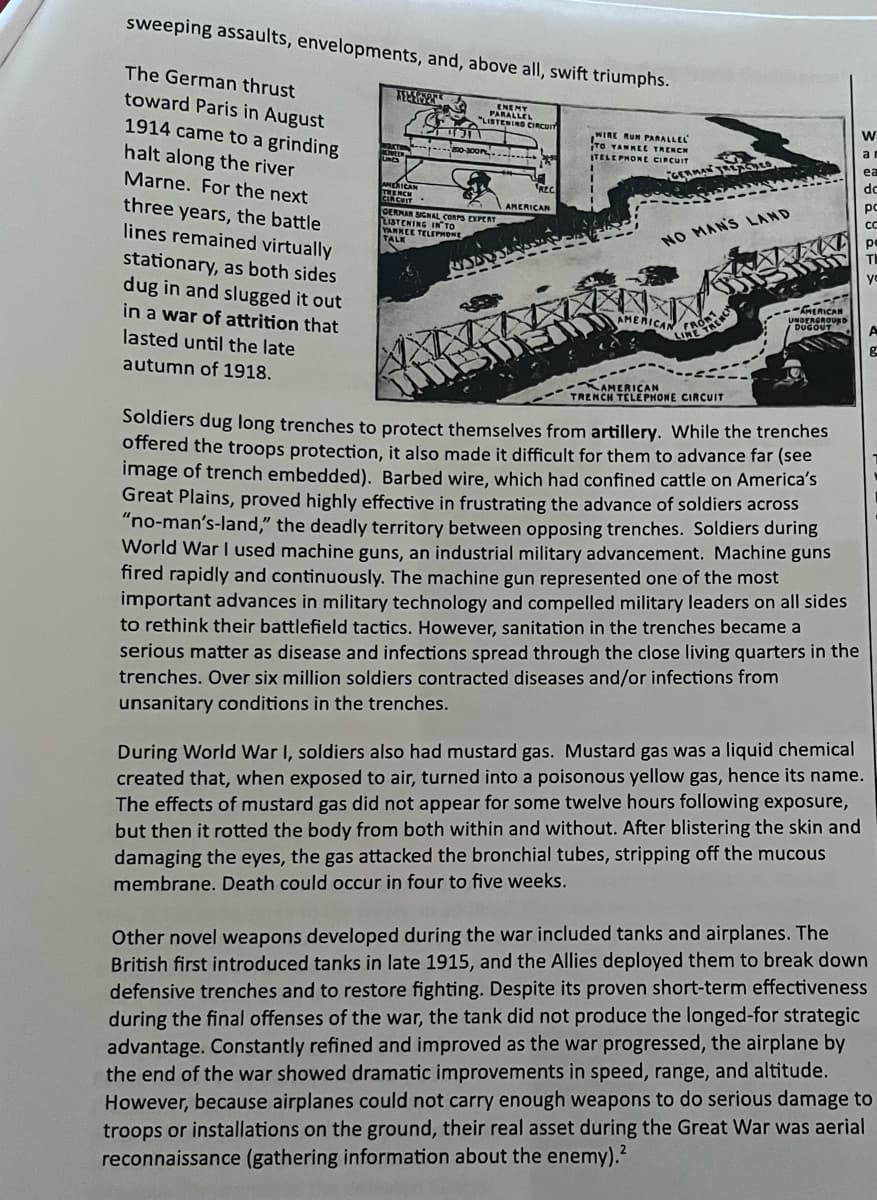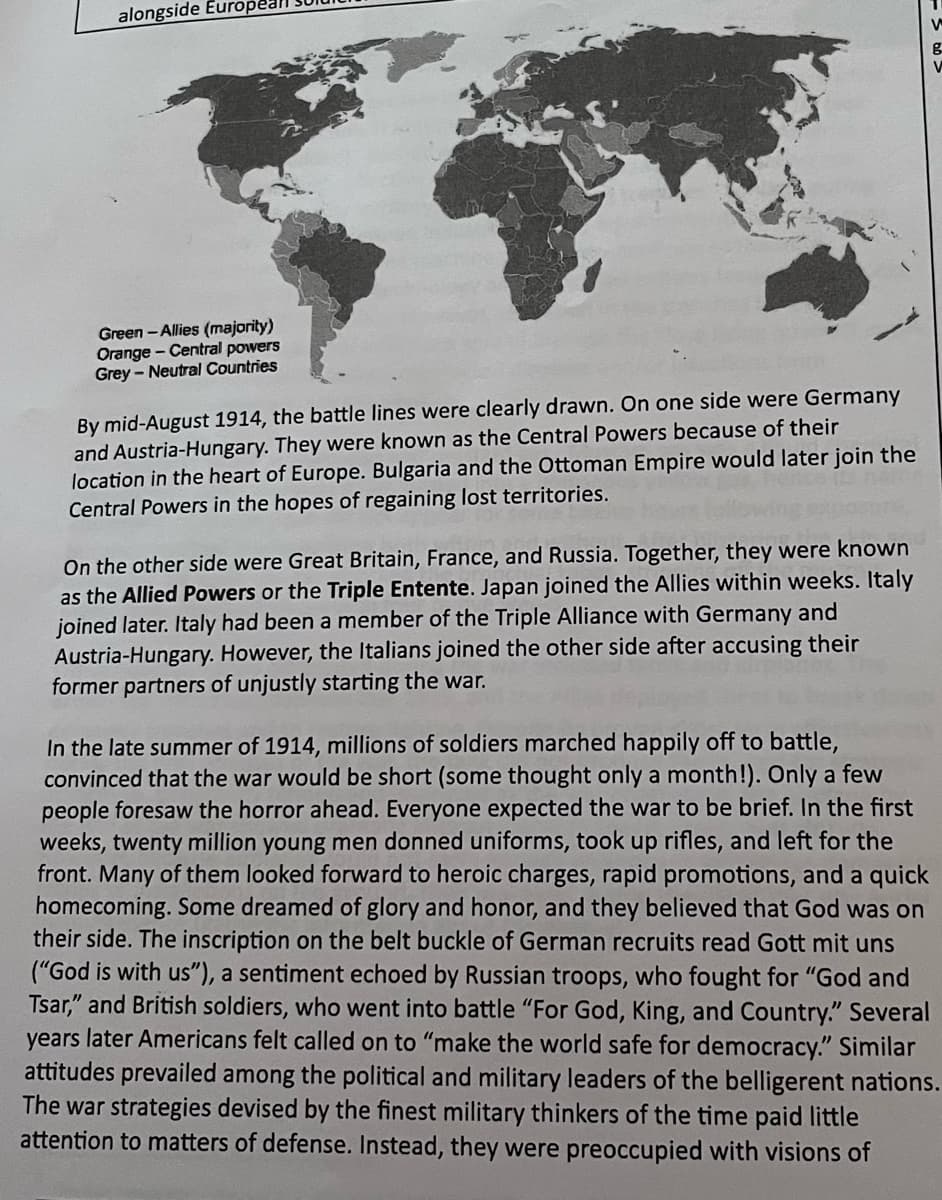What were the causes behind the high number of casualties in WW1? What were the aspects that made WW1 a truly global war?
What were the causes behind the high number of casualties in WW1? What were the aspects that made WW1 a truly global war?
Related questions
Question
What were the causes behind the high number of casualties in WW1?
What were the aspects that made WW1 a truly global war?

Transcribed Image Text:sweeping assaults, envelopments, and, above all, swift triumphs.
The German thrust
toward Paris in August
1914 came to a grinding
halt along the river
ENEMY
PARALLEL
"LISTENING CIRCUIT
WIRE RUN PARALLEL
YANNEE TRENCH
ITELEPHONE CIRCUIT
-o-0on......
a r
ea
GERMA u
de
Marne. For the next
REC
po
AMERICAN
three years, the battle
lines remained virtually
GERMAN SIGNAL CORPS EXPERT
LISTENING INTO
E TELEPHOHE
TALK
NO MANS LAND
stationary, as both sides
dug in and slugged it out
in a war of attrition that
lasted until the late
KHERICAN
UNDERGROUND
DUGOUT
autumn of 1918.
AMERICAN
TRENCH TELEPHONE CIRCUIT
Soldiers dug long trenches to protect themselves from artillery. While the trenches
offered the troops protection, it also made it difficult for them to advance far (see
image of trench embedded). Barbed wire, which had confined cattle on America's
Great Plains, proved highly effective in frustrating the advance of soldiers across
"no-man's-land," the deadly territory between opposing trenches. Soldiers during
World War I used machine guns, an industrial military advancement. Machine guns
fired rapidly and continuously. The machine gun represented one of the most
important advances in military technology and compelled military leaders on all sides
to rethink their battlefield tactics. However, sanitation in the trenches became a
serious matter as disease and infections spread through the close living quarters in the
trenches. Over six million soldiers contracted diseases and/or infections from
unsanitary conditions in the trenches.
During World War I, soldiers also had mustard gas. Mustard gas was a liquid chemical
created that, when exposed to air, turned into a poisonous yellow gas, hence its name.
The effects of mustard gas did not appear for some twelve hours following exposure,
but then it rotted the body from both within and without. After blistering the skin and
damaging the eyes, the gas attacked the bronchial tubes, stripping off the mucous
membrane. Death could occur in four to five weeks.
Other novel weapons developed during the war included tanks and airplanes. The
British first introduced tanks in late 1915, and the Allies deployed them to break down
defensive trenches and to restore fighting. Despite its proven short-term effectiveness
during the final offenses of the war, the tank did not produce the longed-for strategic
advantage. Constantly refined and improved as the war progressed, the airplane by
the end of the war showed dramatic improvements in speed, range, and altitude.
However, because airplanes could not carry enough weapons to do serious damage to
troops or installations on the ground, their real asset during the Great War was aerial
reconnaissance (gathering information about the enemy).?

Transcribed Image Text:alongside Europeall
Green - Allies (majority)
Orange - Central powers
Grey - Neutral Countries
By mid-August 1914, the battle lines were clearly drawn. On one side were Germany
and Austria-Hungary. They were known as the Central Powers because of their
location in the heart of Europe. Bulgaria and the Ottoman Empire would later join the
Central Powers in the hopes of regaining lost territories.
On the other side were Great Britain, France, and Russia. Together, they were known
as the Allied Powers or the Triple Entente. Japan joined the Allies within weeks. Italy
joined later. Italy had been a member of the Triple Alliance with Germany and
Austria-Hungary. However, the Italians joined the other side after accusing their
former partners of unjustly starting the war.
In the late summer of 1914, millions of soldiers marched happily off to battle,
convinced that the war would be short (some thought only a month!). Only a few
people foresaw the horror ahead. Everyone expected the war to be brief. In the first
weeks, twenty million young men donned uniforms, took up rifles, and left for the
front. Many of them looked forward to heroic charges, rapid promotions, and a quick
homecoming. Some dreamed of glory and honor, and they believed that God was on
their side. The inscription on the belt buckle of German recruits read Gott mit uns
("God is with us"), a sentiment echoed by Russian troops, who fought for "God and
Tsar," and British soldiers, who went into battle "For God, King, and Country." Several
years later Americans felt called on to "make the world safe for democracy." Similar
attitudes prevailed among the political and military leaders of the belligerent nations.
The war strategies devised by the finest military thinkers of the time paid little
attention to matters of defense. Instead, they were preoccupied with visions of
Expert Solution
Step 1 Introduction
World War I was a fight that first started with the European countries, but soon it spread in the whole world. This war mainly happened only with the motive of gaining military supremacy.
Step by step
Solved in 3 steps
